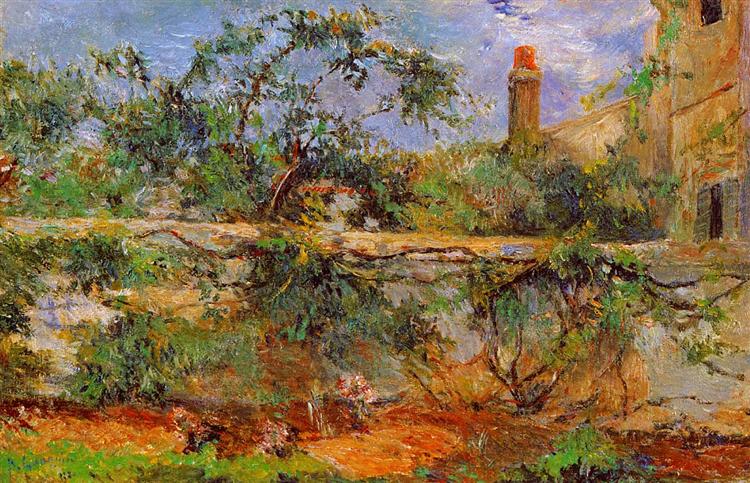Description
The work "Party Wall" (1881), known in English as "Party Wall", is one of the first manifestations of the distinctive style of Paul Gauguin, an artist central to the development of Post-Impressionism. In this painting, one can already observe the characteristics that would mark his later artistic evolution, with an exploration of form, color and atmosphere. The work illustrates an everyday moment that seems trivial at first glance, however, it deepens towards a broader meaning when examining the compositional elements and colors used by Gauguin.
The scene features a dividing wall rising in the center of the canvas, an element that acts as both separation and connection. This wall, with its robust texture and earthy color, seems to be the heart of the work, symbolizing the distance between two realities. On the left, rich vegetation unfolds, while on the right, a simple house can be seen. The symmetrical arrangement of these elements creates a visual balance, suggesting the duality inherent in urban life: the natural versus the built, the private versus the communal.
One of the highlights of “Medianera” is Gauguin’s application of color. The artist was known for his bold, non-naturalistic approach to color, thus influencing the emotion and narrative of the work. In “Medianera,” vibrant shades of greens and blues are used in contrast to the warmth of the wall, creating a distinctive atmosphere that invites the viewer to immerse themselves in the visual experience. This palette is velvety, suggesting a life teeming with history beyond the apparent surface.
In terms of the appearance of characters, the work does not include human figures within the framework of its meaning, reinforcing the implicit dialogue between space and absence. The painting conveys a sense of isolation and the depth of modern life, a theme that Gauguin explored more freely in his later works in Tahiti. This focus on a more symbolic narrative rather than a literal representation of everyday life can be seen as a premonition of his growing discontent with the social landscape and his yearning for cultural authenticity.
To understand the significance of Medianera, it is helpful to contextualize it within the period in which it was created. Gauguin was in the process of redefining himself as an artist, moving away from the Impressionist movement that was dominant at the time. His journey toward the symbolic use of color and form not only anticipates the more iconic works that would follow, but also establishes a bridge to symbolism and other currents that would challenge traditional aesthetics.
In conclusion, Paul Gauguin's "Medianera" is a work that, despite its simplicity, presents a remarkable complexity. With its balanced composition and vibrant palette, the canvas becomes a space of exploration not only of the physical environment, but also of the duality of human experience. This painting serves as a testament to Gauguin's early development, foreshadowing his future search for a deeper, spiritual meaning in art, forging a path towards modernity in painting. The evocation of the sense of place and the use of color are not only characteristic of his style, but also an invitation to connect with the more subtle aspects of contemporary life.
KUADROS ©, a famous painting on your wall.
Hand-made oil painting reproductions, with the quality of professional artists and the distinctive seal of KUADROS ©.
Painting reproduction service with satisfaction guarantee. If you are not completely satisfied with the replica of your painting, we will refund 100% of your money.

